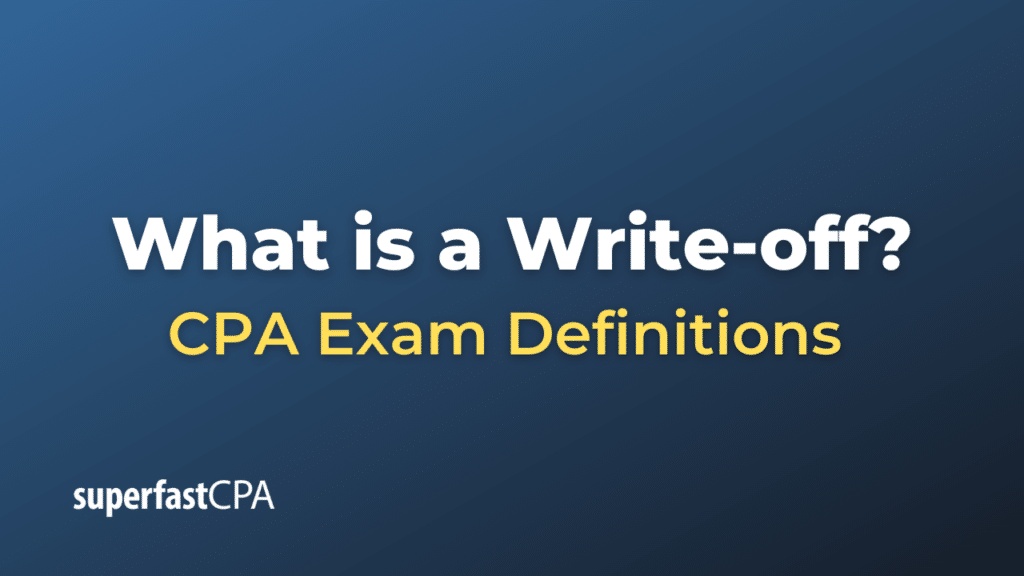Write-off
In accounting, a write-off refers to the action of reducing the value of an asset or recognizing that certain amounts are unrecoverable, either fully or partially. The purpose is to align the book value of assets or revenues with their actual worth. When an asset is written off, it usually results in an expense being recognized in the income statement, which consequently affects the balance sheet.
Here are some common examples:
Bad Debt Write-off
Suppose a company has an accounts receivable of $10,000 from a customer. After several attempts to collect the amount, the company determines that the customer is not going to pay. The $10,000 is then considered “uncollectible” and must be written off.
The journal entry to write off the bad debt would typically involve:
- Debit: Bad Debt Expense $10,000
- Credit: Accounts Receivable $10,000
This entry reduces the accounts receivable on the balance sheet and recognizes an expense on the income statement.
Inventory Write-off
Let’s say a grocery store realizes that a part of its produce has spoiled and cannot be sold anymore. The store has to write off the value of the spoiled produce as a loss.
The journal entry might be:
- Debit: Loss on Inventory Write-off $2,000 (this goes into the income statement)
- Credit: Inventory $2,000 (this reduces the value of inventory on the balance sheet)
Asset Depreciation and Write-downs
For long-term tangible assets like machinery or buildings, companies generally use depreciation to write off the asset’s cost over its useful life. Occasionally, assets may also be subject to “write-downs” if their market value drops suddenly and significantly.
For example, if a company owns a machine originally valued at $50,000 but determines it is now only worth $30,000 due to obsolescence, it would need to write down the machine’s value by $20,000:
- Debit: Impairment Loss $20,000 (recognized in the income statement)
- Credit: Machine’s carrying amount $20,000 (reducing the value on the balance sheet)
By writing off or writing down assets or receivables, companies ensure that their financial statements present a more accurate and honest picture of their financial health.
Example of a Write-off
Let’s use the example of a bad debt write-off to illustrate how a write-off works in accounting.
Scenario: Bad Debt Write-off
Suppose you own a small business called “Tech Haven,” which sells electronics. One of your customers, John, purchased a high-end laptop worth $2,000 on credit. He promised to pay within 30 days, but despite repeated reminders, he hasn’t made the payment, and it has been 90 days.
After multiple unsuccessful attempts to collect the debt and assess his financial condition, you determine that John is unlikely to pay back the amount. At this point, you decide to write off the $2,000 as a bad debt.
Journal Entry
To record the write-off, you would make the following journal entry in your accounting records:
- Debit: Bad Debt Expense $2,000
- Credit: Accounts Receivable $2,000
This entry has the following effects on your financial statements:
- Income Statement: A bad debt expense of $2,000 will appear, which will reduce your net income.
- Balance Sheet: The accounts receivable will be reduced by $2,000, thus reflecting a more accurate picture of the amounts you expect to collect in the future.
Financial Statements Before and After the Write-off
Before Write-off
- Income Statement: Net Income = $10,000 (for simplicity)
- Balance Sheet: Accounts Receivable = $10,000
After Write-off
- Income Statement: Net Income = $10,000 – $2,000 (Bad Debt Expense) = $8,000
- Balance Sheet: Accounts Receivable = $10,000 – $2,000 = $8,000
By writing off the bad debt, your financial statements now provide a more accurate representation of your business’s financial health, acknowledging that you have an uncollectible debt of $2,000.













